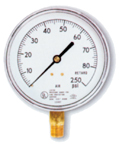
| Your buildings sprinkler system isn't just piping and sprinkler heads. It is a complex system designed to effectively suppress or extinguish a fire when properly maintained. |

| Everything on your sprinkler system is important gauges are read weekly and monthly to ensure proper PSI reading. This ensures proper operation in the event of a fire these readings must be kept in a complete log for local authorities if they request them. Did you know that gauges must be changed or re calibrated every 5 years? |
| We have 20 years of on the job experience in the sprinkler trade. A sprinkler inspection is fire code and is also required by your local by laws and insurance standards across Canada. A properly maintained sprinkler system can last for years. Poorly maintained and they are replace in just a few years. Don't pay fire alarm technicians to inspect your sprinkler systems call us. We are the ones they call to trouble shot DRY system troubles, wet system false alarms and even to check coverage for insurance companies. Every time we do work for these companies we see the same thing over and over again. The system hasn't been properly tested and maintained. A sprinkler system that isn't properly maintained can cause tens of thousands of dollars in damage. Don't let this happen to you . Call the company every one else calls SCO Fire & Life Safety 416-901-9198 |
| We are not sprinkler fitters!!! A sprinkler fitter is highly skilled union worker with special training pertaining to installation of piping/Valves etc...In the construction of buildings We are suppression technicians with the mechanical manuals and mechanical experience for all existing sprinkler alarm bodies, special suppression systems and dry systems. We have fabricators to make any of the gaskets or other internal parts that a system may require. If you need piping installed then you need to call a sprinkler fitter. If you need a sprinkler inspection then you need a professional Call us at SCO we want to help. |
| Having problems with your dry system? Call us we CAN HELP!!! 416-901-9198 |
Sprinkler piping systems which maintain a charge of water such
as fire sprinkler systems commonly employ alarm valves which
indicate flow through the system. In turn, such flow indicates
use of the system such as during a fire sprinkler discharge, fire
hose activation or the like. The alarms associated with such
systems are commonly mechanical in nature to activate a local
gong. Switches associated with electric alarm circuits may also
be employed. Such systems are designed to detect flow
indicative of proper operation of the system. With a first
sprinkler system, the flow detected may be in the range of 15
GPM and above. For example, a flow of 10 GPM might reflect
the discharge of a single fire sprinkler associated with the
piping system.
Such alarms are typically arranged in a vertical rise of pipe
which includes a valve body having a seat and a pivotally
mounted flapper valve. The seat typically employs a groove in
the sealing face thereof extending fully thereabout. A vent from
the groove extends to atmosphere through a restricting orifice,
a retard chamber and a conventional flow alarm device. When
the flapper valve is opened by flow through the piping, the
groove is exposed to the liquid and a small amount of flow is
allowed to pass through the restricting orifice and ultimately
activate the flow alarm device.
Piping systems employing such valves such as fire sprinklers
are charged with liquid and then sealed. The liquid, typically
water from a community water supply, is heated by the ambient
conditions about the system to raise the pressure within the
piping above that of the supply. This results in the pressure
within the system rising significantly above the pressure within
the water supply. This rise is also greater than the often
experienced spikes in pressure within such supply systems.
This overpressure within the piping system maintains the
flapper valve within the alarm valve closed.
Further, regulations also frequently require back flow
preventer's in fire sprinkler systems. The water within the piping
is stagnant and can accumulate impurities and organisms
detrimental to the integrity of a community water supply. Such
back flow preventer's are typically check valves such as a
spring biased flapper held against a seat. Such back flow
preventer's are unable to be monitored for leakage. Further,
they do not monitor the integrity of the alarm valve without
removal. Even then, only substantial dysfunction in the back
flow preventer is likely to be detected.
as fire sprinkler systems commonly employ alarm valves which
indicate flow through the system. In turn, such flow indicates
use of the system such as during a fire sprinkler discharge, fire
hose activation or the like. The alarms associated with such
systems are commonly mechanical in nature to activate a local
gong. Switches associated with electric alarm circuits may also
be employed. Such systems are designed to detect flow
indicative of proper operation of the system. With a first
sprinkler system, the flow detected may be in the range of 15
GPM and above. For example, a flow of 10 GPM might reflect
the discharge of a single fire sprinkler associated with the
piping system.
Such alarms are typically arranged in a vertical rise of pipe
which includes a valve body having a seat and a pivotally
mounted flapper valve. The seat typically employs a groove in
the sealing face thereof extending fully thereabout. A vent from
the groove extends to atmosphere through a restricting orifice,
a retard chamber and a conventional flow alarm device. When
the flapper valve is opened by flow through the piping, the
groove is exposed to the liquid and a small amount of flow is
allowed to pass through the restricting orifice and ultimately
activate the flow alarm device.
Piping systems employing such valves such as fire sprinklers
are charged with liquid and then sealed. The liquid, typically
water from a community water supply, is heated by the ambient
conditions about the system to raise the pressure within the
piping above that of the supply. This results in the pressure
within the system rising significantly above the pressure within
the water supply. This rise is also greater than the often
experienced spikes in pressure within such supply systems.
This overpressure within the piping system maintains the
flapper valve within the alarm valve closed.
Further, regulations also frequently require back flow
preventer's in fire sprinkler systems. The water within the piping
is stagnant and can accumulate impurities and organisms
detrimental to the integrity of a community water supply. Such
back flow preventer's are typically check valves such as a
spring biased flapper held against a seat. Such back flow
preventer's are unable to be monitored for leakage. Further,
they do not monitor the integrity of the alarm valve without
removal. Even then, only substantial dysfunction in the back
flow preventer is likely to be detected.
| Read this article if you want to know what a sprinkler system really is!!! |
| Having problems with your dry system? Call us we CAN HELP!!! 416-901-9198 |

| 416-901-9198 |
| Call us for your free estimate. 416 901 9198 |
Our inspection procedures include:
• Exercising control valves and testing tamper switches
• Ensuring local and electronic alarm devices function properly
• Operating inspectors test valve to ensure operation of flow switch(s)
• Performing main drain test and tag each riser with static and residual pressure readings
• Inspecting sprinkler heads for rating, damage, obstructions, or corrosion
• Inspecting fire department connection for obstructions and caps
• Inspecting, testing and recording Antifreeze system readings
• Testing water flow and operation of fire pumps and jockey pumps
• Trip testing Dry-pipe, Pre-action and Deluge valves as applicable
• Inspecting gravity tanks, reservoirs and pressure tanks
• SCO Fire & Life Safety provides you with a detailed report of the operation and conditions
of your system to comply with the standards for records in Ontario.
• Exercising control valves and testing tamper switches
• Ensuring local and electronic alarm devices function properly
• Operating inspectors test valve to ensure operation of flow switch(s)
• Performing main drain test and tag each riser with static and residual pressure readings
• Inspecting sprinkler heads for rating, damage, obstructions, or corrosion
• Inspecting fire department connection for obstructions and caps
• Inspecting, testing and recording Antifreeze system readings
• Testing water flow and operation of fire pumps and jockey pumps
• Trip testing Dry-pipe, Pre-action and Deluge valves as applicable
• Inspecting gravity tanks, reservoirs and pressure tanks
• SCO Fire & Life Safety provides you with a detailed report of the operation and conditions
of your system to comply with the standards for records in Ontario.
| Call us for your free estimate. 416 901 9198 |
| Call us for your free estimate. 416 901 9198 |
DON'T NEGLECT YOUR SPRINKLER SYSTEM




